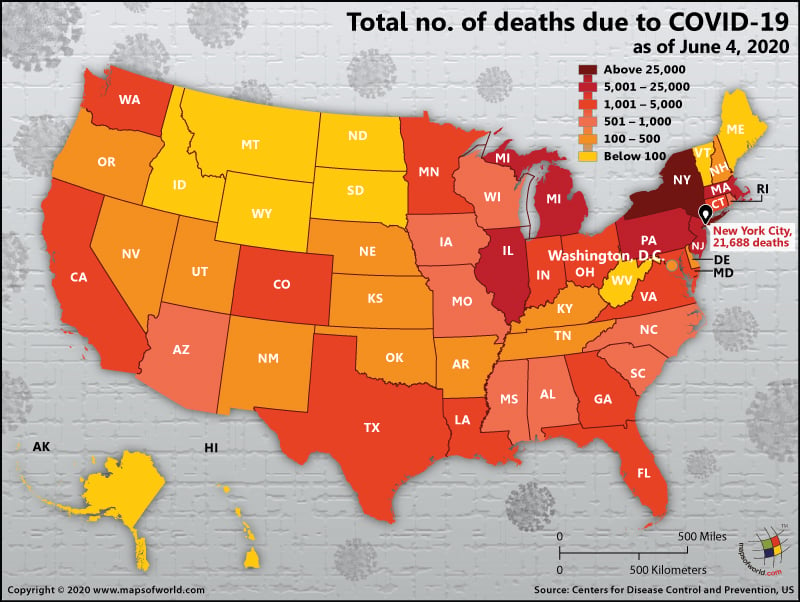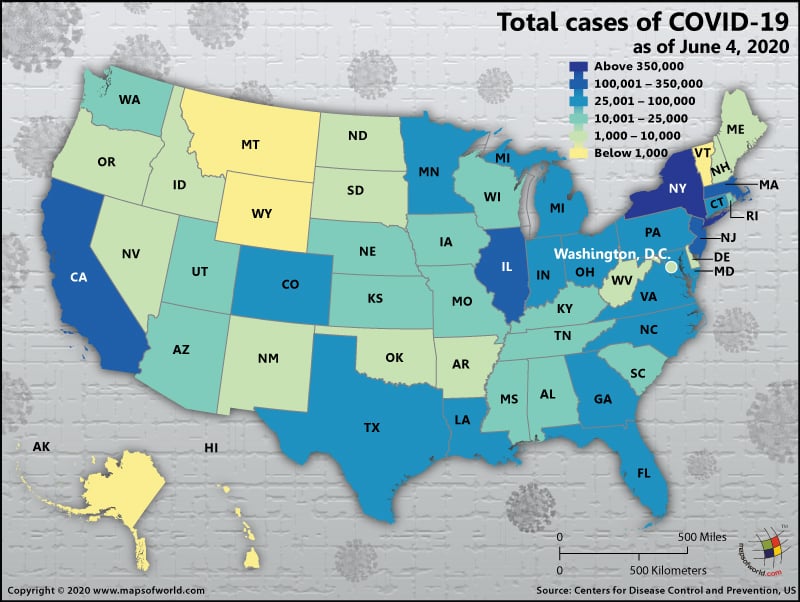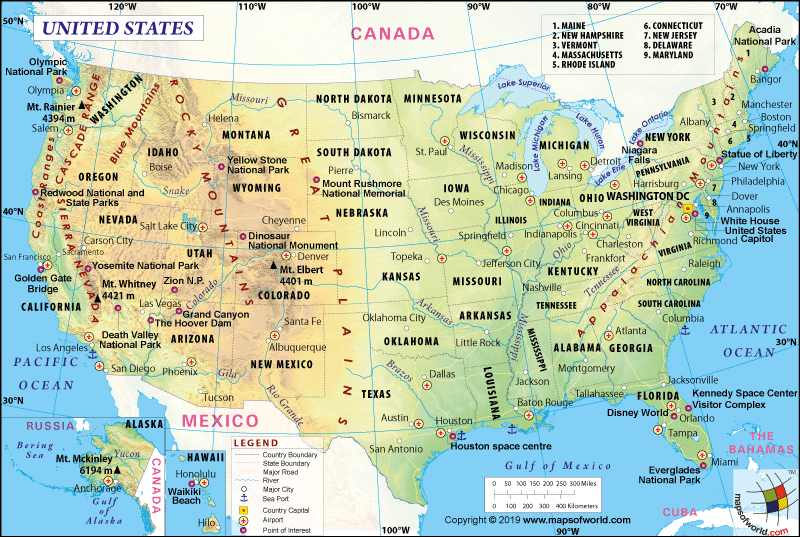The Success, Failure and Economic Upheaval of US During Coronavirus Crisis

COVID-19 pandemic 2020 is getting worse in the US. New York State is the worst affected state. The death toll in New York soars to 30,011.
Though President Donald Trump has announced federal recommendations to practice physical distancing on March 29, 2020, and recommended to continue it till the end of April to limit the damage, the leading economy of the world is grappling to contain the spiraling situation. Restrictions are easing in many of the US states in the month of June.
Before checking further into the effects of COVID-19 pandemic in the USA, let’s have a quick look at the scenario world over.
COVID-19 Cases & Death Toll across the World
The virus that originated in China’s Wuhan city (in Hubei Province) on December 31, 2019, has now spread to 203 countries and territories.
World Health Organization’s (WHO) Director-General Dr. Tedros Adhanom Ghebreyesus declared it a full-blown pandemic on March 11, 2020.
At the time when WHO declared COVID-19 as a pandemic, more than 118,000 were infected, and 4,291 people died from the novel coronavirus across the world.
As per John Hopkins University & Medicine’s Coronavirus Resource Center, COVID-19 infection has spread to 6,639,092 people across the world, and the global death toll stands at 391,249 as of June 5, 2020.
COVID-19 Cases and Death Toll in the US
The country that tops the list with the maximum number of confirmed infection cases of COVID-19 is the United States. As of June 4, 2020, there are 1,842,101 confirmed cases with 14,676 new cases of infection in the US, followed by Brazil (614,941), Russia (440,538), UK (283,079), and Spain (240,660).
The spread of COVID-19 in the United States in 2020 started almost one month after it originated in Wuhan. The first case of COVID-19 infection in the US occurred on January 21, 2020. As of June 4, 107,029 people have died in the US.

Worst Affected US States due to COVID-19
Data collected by Johns Hopkins University’s Center for Systems Science and Engineering (CSSE) on April June 5 shows that the worst affected US States are:
- New York US – 375,133 confirmed
- New Jersey US – 162,530 confirmed
- Illinois US – 124,759 confirmed
- California US – 122,168 confirmed
- Massachusetts US – 102,063 confirmed
- Pennsylvania US – 78,335 confirmed
Effect of the Coronavirus Crisis on the US Economy
Unemployment and Job Loss Scenario in the US
Data published by the US Labor Department on April 3, 2020 (Friday) shows that lockdowns and other measures undertaken by the US administration to contain the COVID-19 outbreak in the United States led to the loss of 701,000 jobs in March 2020. The rate of unemployment has increased by 4.4% in March 2020.
Reports say that it is the worst job-loss scenario since March 2009, the worst phase of the global financial crisis. Over 3.28 million Americans have reportedly applied for unemployment benefits, which is the highest number ever recorded in the US.
May’s number was even more dire with another 7.5 million jobs lost and an unemployment rate near 20%.
Layoffs have started in multi-tier businesses. The small businesses are the worst affected and are struggling to keep staff on payroll. Many are resorting to layoffs as their revenue slump. The jobless rate is the highest in more than 45-years of American history.
Consumption Scenario in the US
As businesses remain closed and households curtail their significant consumption (due to their worry about finances and jobs), the consumption sector in the US is witnessing a slump. As the consumption sector constitutes 70% of the American GDP, it will have a multiplier effect on the US economy as a whole.
Investment Scenario in the US
Businesses are vying to know the full cost of the COVID-19 pandemic on the US as well as the world. That’s why they are currently putting off newer investments. As investment constitutes around 20% of the GDP, it is undoubtedly going to hurt the growth potential of the US economy.
Manufacturing Scenario in the US
Many manufacturing companies (such as Ford and General Motors) have temporarily stopped and closed their factories in anticipation of reduced demand. The 2020 coronavirus pandemic has obstructed the global supply chain, adversely affecting the production scenario of the manufacturing sector. As the manufacturing sector constitutes around 11% of the GDP, it is expected to hit the US economy hard.
Entertainment & Hospitality Scenario in the US
The entertainment and hospitality industry (including arts, restaurants, recreation, and entertainment) make up 4.2% of GDP. However, the COVID-19 pandemic and consequent lockdowns have led to the closure of movie theaters and restaurants. Though its contribution to the US GDP is comparatively lower, it is a labor-intensive industry. That’s why its multiplier effect on the US economy will be multifold.
A new report published by the UN Department of Economic and Social Affairs says that the global economy will grow at just 1% in 2020 instead of the pre-pandemic growth projection of 2.5%.
What are the Failures of the US in dealing with the COVID-19 pandemic?
-
Failure #1: Conflicting Statements of the US President Donald Trump on the Seriousness of COVID-19 Pandemic
Just 1-month back, the US President Donald Trump claimed that the COVID-19 was “very much under control.” However, he has now warned that the COVID-19 pandemic is going to get much worse.
Trump’s message to the public changed from confidently downplaying the crisis (by saying COVID-19 will dissipate “like a miracle” in the summer) to a panic-ridden comment “I want every American to be prepared for the hard days that lie ahead.”
Once the total confirmed infection count crossed 300,000, Trump announced (on Sunday, April 5, 2020) that it is going to be “the hardest and saddest week of most Americans’ lives.” He went on to warn that the death toll from COVID-19 in the US can be similar to that witnessed during “World War One or Two or something.”
Whiplash messaging and political squabbles made the situation worse. Though a week earlier, President Trump said that the businesses could reopen by mid-April Easter holiday, his comment asking Americans to prepare for hard days is in complete contrast. The prediction of at least 100,000 American deaths by the public health advisers not only panicked US citizens but also put the public’s faith in the administration at stake.
Professor Jeffrey Levi, a George Washington University professor of health policy and management, said that messages could sometimes change due to the continually changing environment of a pandemic but not in the manner Trump did.
However, President Trump’s statement reflected political concern instead of the ground realities. At a time when the political class needed to unite and fight against COVID-19 pandemic, Trump criticized New York’s governor and belittled Gretchen Whitmer of Michigan.
-
Failure #2: The US doesn’t have a National Plan Yet, It is still in a Reactive Mode
a. Jeremy Konyndyk (former head of the US Agency for International Development’s disaster response and a senior policy fellow at the Center for Global Development) has said that the US is “in a reactive mode” instead of prevention mode. He went on to say that “this is a virus that punishes delay. … We’re still chasing the virus.”
b. The Director of the Center for Infectious Disease Research and Policy at the University of Minnesota, a renowned epidemiologist Dr. Michael Osterholm, has also said that the US doesn’t have any national plan yet. He said: “We are going from a press conference to press conference and crisis to crisis … trying to understand our response”.
c. Osterholm and many other experts in the field of infectious diseases have chalked out a flurry of battle plans in the past week for containing the spiraling COVID-19 infection in the United States. While many officials have signaled support for the plan, it is still not clear whether the US Federal government can implement the plan in all the 50 US States and territories as the latter have a history of fierce resistance to centralized authority. The situation is becoming worse with every passing day. An analysis of 12 mathematical models shows that there are high chances of millions of people to get infected from the COVID19 coronavirus infection.
d. White House coronavirus response coordinator, Deborah Birx, has repeatedly said that even after following different precautionary measures (including physical distancing), the death toll may exceed 100,000.
e. Vice President Michael Richard Pence has said the models suggest that the trajectory of coronavirus outbreak in the US is similar to that of Italy. With more than 33,689 deaths and 234,013 confirmed cases of infection in Italy, Pence’s comment shows that the true figure of infection cases and death is going to get much higher than that suggested by the mathematical models.
-
Failure #3: Medical Supply Shortages are glaring in the US
The situation is so unfortunate in the US that officials across the country are finding it tough to get proper protective gear/supplies (be it masks, gloves, gowns, or others) for hospital staff as well as enough ventilators for the severe patients.
Ventilators are essential for COVID-19 severe patients. A shortage of ventilators is forcing the state officials to perform medical triage. They have to pick and choose based on the health condition.
They have to decide whom to provide the life-sustaining support and whom to deny. It is an excruciating decision they have to make in the absence of adequate ventilators. The New York Governor Andrew Cuomo complained that the prices of the ventilator are soaring high as the US states are not only competing with each other but also with the US federal government. In his own words: “It’s like being on eBay with 50 other states, bidding on a ventilator.”
Health policy and management professor at George Washington University, Jeffrey Levi, said that the condition could have been better if the US government adequately maintained the supply stockpiles required for dealing in a pandemic. Levi went on to say that the US government was too slow in dealing with the pandemic and only reacted after the COVID-19 pandemic blew up in the US.
To deal with this extreme shortage situation, the Trump administration has adopted aggressive tactics to outbid other countries and procure Personal Protective Equipment (PPE), essential medical masks, and other protective gear/supplies. While Spain, Canada, and Brazil have expressed their frustration, Germany has regarded the US tactics as “modern piracy.”
-
Failure #4: Delay in Testing
To fight successfully against a severe viral outbreak such as COVID-19, ramping up testing at an early date is crucial. Two countries (Singapore and South Korea) were successful in controlling the coronavirus pandemic in their countries and flattening the curve by testing and detecting COVID-19 patients early.
However, the US government ultimately failed to test and identify COVID-19 patients early. The subsequent complications cascaded.
Experts are putting the onus of early testing failure on the Trump administration, which completely disregarded pandemic response plans.
There is a considerable difference between the administration’s promise and actuality. While the administration promised at least 5 million testings by the end of March, just a million tests were conducted.
As there were initial shortages, the labs testing now are overwhelmed. This has led to weeks of delay. Even if a person is COVID-19 positive, he/she comes to know about the result at least a week later. This delay is also increasing the chances of further spread of the infection among family members (even if social/physical distancing is maintained strictly).
-
Failure #5: Failure in Maintaining Social/Physical Distancing
Overall, Americans didn’t hear the calls of the public health professionals of social and physical distancing to avoid the spread of COVID-19 pandemic in the US. Whether it is the Florida beaches, some religious congregation (such as Pastor Tony Spell in a Louisiana church), or subways filled with office going persons in New York, the Americans didn’t maintain physical distancing.
Due to conflicting remarks by the political leaders led by the US President Donald Trump, many local and state government officials were found reluctant in ordering businesses to close their shutters and urge citizens to stay at home.
The abrupt lockdown of the New York subways led to overcrowding of trains and buses. With the universities sending students home have also reportedly contributed to the spread of COVID-19 to the families and localities of the infected students. It is especially true as the neighborhoods and homes were not yet in full lockdown at that time.
After President Trump’s order of halting the entry of passengers from European countries, people confused the order is meant for the US citizens too and therefore led to crowding in the airports. As the airport was unscreened, the infected passengers easily transmitted the disease.
What are the Successes of the US in dealing with the COVID-19 pandemic?
-
Success #1: Grand Stimulus Package for All
The US Congress has passed a $2 trillion stimulus bill called “CARES” Act-2020 on March 27 to help the US economy. CARES stands for “Coronavirus Aid, Relief, and Economic Security.”
The main financial assistance included in the CARES Act 2020 is direct payment transfers in bank accounts of individuals, direct economic stimulus funding to states, territories, local and tribal government, emergency reliefs and taxpayers protection, and health provisions.
Both the US President Donald Trump and Democratic Speaker of the House Nancy Pelosi have discussed working on another bill, which is likely to infuse investment in the infrastructure sector and also provide additional healthcare benefits.
-
Success #2: US Research Firepower: Long-Term Prospects of Vaccine and Therapeutic Development is getting Better
The COVID-19 coronavirus pandemic has exposed the yawning flaws in the US healthcare system, especially at the time of a pandemic. The fast spread of the infection across the US and more than 108,211 deaths have made the pharmaceutical companies in the US to research and develop a vaccine.
Pharmaceutical companies, as well as the government, are trying to develop drug infrastructure, which is strong enough to sail through any pandemic with the least adverse effect and casualties.
Some experts such as director of the US National Institute of Allergy and Infectious Diseases, Anthony Fauci, believe that a vaccine will be available for production in at least a year.
-
Success #3: Many State Leaderships are making Great Decisions
The US federal system provides broad powers to the individual states. At the time of this pandemic, governors are making decisions of their own.
Two governors are especially worth mentioning. California’s Gavin Newsom and Washington Jay Inslee took early steps. They ordered early closure of schools and, at the same time, issued shelter-in-place orders. These steps helped in the slower spread of the COVID-19. Ohio Governor Mike DeWine also needs special mention as his decisive early moves helped check the indiscriminate spread of the infection.
Conclusion
Is there a Political Will to Contain Spread of COVID-19 Pandemic in the US?
Many political scientists say that in the case of pandemics, the best rule of communication is to provide a message and stick to it.
The lack of clarity from the administration is hemorrhaging the reservoir of people’s trust. That’s why the administration is finding it difficult to immediately adopt Non-Pharmaceutical Interventions (NPIs) such as physical distancing.
Biologists and experts say that NPIs are found to be most effective in a pandemic when there is no vaccine or lack of pharmaceuticals (similar to the current situation).
The political will of the politicians in the United States is also coming in the way of decisive action. Polls have found that the Independents and Democrats consider the COVID-19 pandemic a grave matter. However, the Republicans, in general, perceive it a lesser threat, thereby hampering the administration (whether federal, state-level, or local) to take decisive action.
Where is the CDC?
The lack of national leadership from the U.S. Centers for Disease Control and Prevention (CDC) during the novel coronavirus pandemic has dismayed some public health experts. CDC is still the most trusted source of information for Americans.
How Long will the lockdown Continue?
The Director of the Center for Infectious Disease Research and Policy at the University of Minnesota, Dr. Michael Osterholm, has said that dealing with the COVID-19 pandemic is not a sprint but a marathon. He believes that the US may have to deal with its effects for many months. Some reports already indicate that the restrictions imposed by the federal, state, and local administration will continue till June.
If lockdowns are successful in containing the spread of the coronavirus, just like China, then the next task will be to marshal massive resources for monitoring new outbreaks and containing them quickly once they appear.
Is the $2 Trillion CARES Enough?
US President Donald Trump has signed the $2 trillion CARES (Coronavirus Aid, Relief, and Economic Security) Act to stimulate the economy. However, progressive Senators and Democratic Presidential hopeful for 2020 US Presidential election Bernie Sanders is pushing for “Priorities for the Next Coronavirus Relief Package,” which vouches for many progressive economic stimuli generally kept untouched in American politics.
Sanders called for the federal government to provide $2,000 monthly payment of an emergency payment to all Americans (“including the undocumented, the homeless, the unbanked, and young adults excluded from the CARES ACT”) until the novel coronavirus pandemic is over. In sync with the recent guidelines of IMF and WHO, Sanders has asked to freeze all monthly rents and mortgage payments of all Americans.
Related Link:

